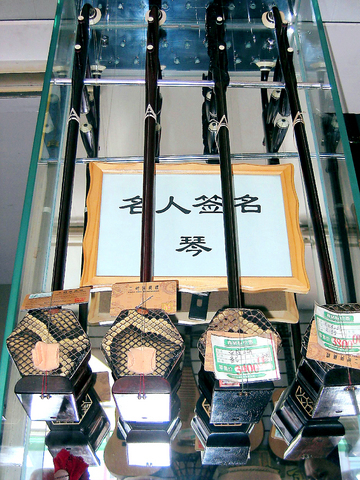he sad and sonorous sound of the erhu, the musical instrument that epitomizes Chinese music, is weathering an attack from nature lovers who fear its snake skin covered sound box is driving the mighty python into extinction.
Favorably compared to the violin, the erhu is revered in China for its natural sound and has long been viewed as the instrument that best reflects the human voice, most notably a weeping lady.
Countless pieces of music, mostly sad and melancholy, have been written for the long-necked two-stringed instrument, played with a horsehair bow and boasting a more than 1,000 year history.

PHOTO: AFP
"The most important part of the erhu is the python skin, the reverberations of the skin give the erhu its unique sound," said Yang Youlin, manager of the Beijing Music Book Store.
"Without the python skin, an erhu is not an erhu. Snake skin, sheep skin, wood, won't do."
Even the cost of an erhu, which range up to 8,000 yuan (US$1,000), depends on what part of the python is used for the sound box membrane, with seasoned erhu players preferring the belly side of the snake near the tail, Yang said.

PHOTO: AFP
"A lot of factors go into the sound -- the age of the snake, the size and the uniformity of the scales and the thickness of the skin are all important," Yang said.
The problem is that with China's economy booming, more and more people are buying and learning to play the instrument.
China's opening up to the West has also ensured that an increasing number of overseas fans, especially in Japan and Singapore, are also buying the instrument.
Other instruments, like the sanxian, a three stringed plucked instrument, also uses a python skinned sound box, while python skins have long been used for Chinese drums and tambourines.
The nation's growing demand for python is further stepping up competition internationally where python skins are valued in the usual reptilian fare of purses, wallets, jackets, boots, belts and bags.
"The python has been nearly extinct in China in the wild since the 1980s and much of this is because of the demand for python skins in the music industry," said Xu Hongfa, a wildlife trade expert for TRAFFIC East Asia, a group that monitors the trafficking in endangered species.
"Since then, the wild populations in Southeast Asia have begun to fall and the smuggling of python skins from Southeast Asia into China has grown."
A relish for python meat in southern China, he said, has also played a role in the demise of the snake that thrives in a jungle setting and can grow to up to 6m long.
After ratifying the UN Convention on the International Trade in Endangered Species (CITES), China passed its Law on the Protection of Endangered Species in 1988, effectively making the unlicensed use and trade in pythons illegal, Xu said.
But implementation of the law has not been easy, prompting TRAFFIC East Asia and other environmental groups to work with the State Forestry Administration to set up a certification process between python skin sellers in Southeast Asia and musical instrument factories in China.
New regulations that went into effect on Jan. 1 also require that all erhus have a certificate from the administration, which certify that the erhu python skin is not made with wild pythons, but from farm-raised pythons, he said.
Individuals are now only allowed to take two erhus out of China when travelling, while commercial buyers also need additional export certificates.
"The situation was getting out of hand, so the government had to do something," said Feng Yuankai, spokesman for the China Musical Instrument Association.
"Basically the manufacturers have supported and embraced the new policy as a way to maintain a sustainable industry, the certification also means that they are legally trading in python skins, which was not the case before the new regulations."
In 2003, China's nearly 100 erhu manufacturing enterprises used some 30,000 python skins to produce about 400,000 erhus, with production expected to continue rising with growing international demand, Feng said.
"This is a 1,000-year-old tradition in China, so at first I think that the manufacturers were not too happy about the new policy," said TRAFFIC East Asia's Hu.
"The new regulations have resulted in the price of python skin rising by almost 100 percent, but now the manufacturers are finding that they can raise the price of their erhu as well, which I think they like."

Exceptions to the rule are sometimes revealing. For a brief few years, there was an emerging ideological split between the Democratic Progressive Party (DPP) and Chinese Nationalist Party (KMT) that appeared to be pushing the DPP in a direction that would be considered more liberal, and the KMT more conservative. In the previous column, “The KMT-DPP’s bureaucrat-led developmental state” (Dec. 11, page 12), we examined how Taiwan’s democratic system developed, and how both the two main parties largely accepted a similar consensus on how Taiwan should be run domestically and did not split along the left-right lines more familiar in

As I finally slid into the warm embrace of the hot, clifftop pool, it was a serene moment of reflection. The sound of the river reflected off the cave walls, the white of our camping lights reflected off the dark, shimmering surface of the water, and I reflected on how fortunate I was to be here. After all, the beautiful walk through narrow canyons that had brought us here had been inaccessible for five years — and will be again soon. The day had started at the Huisun Forest Area (惠蓀林場), at the end of Nantou County Route 80, north and east

Specialty sandwiches loaded with the contents of an entire charcuterie board, overflowing with sauces, creams and all manner of creative add-ons, is perhaps one of the biggest global food trends of this year. From London to New York, lines form down the block for mortadella, burrata, pistachio and more stuffed between slices of fresh sourdough, rye or focaccia. To try the trend in Taipei, Munchies Mafia is for sure the spot — could this be the best sandwich in town? Carlos from Spain and Sergio from Mexico opened this spot just seven months ago. The two met working in the

This month the government ordered a one-year block of Xiaohongshu (小紅書) or Rednote, a Chinese social media platform with more than 3 million users in Taiwan. The government pointed to widespread fraud activity on the platform, along with cybersecurity failures. Officials said that they had reached out to the company and asked it to change. However, they received no response. The pro-China parties, the Chinese Nationalist Party (KMT) and Taiwan People’s Party (TPP), immediately swung into action, denouncing the ban as an attack on free speech. This “free speech” claim was then echoed by the People’s Republic of China (PRC),